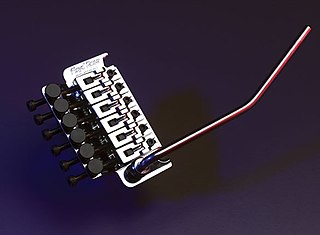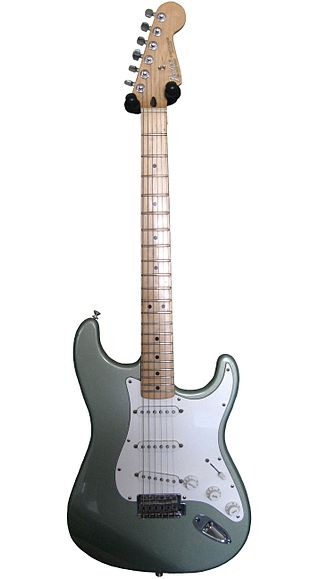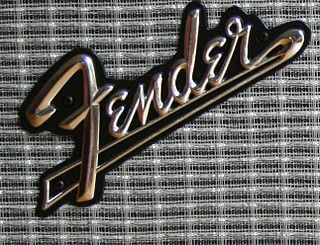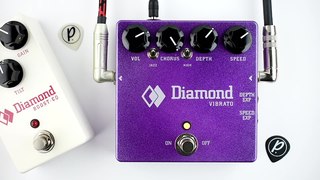
An electric guitar is a guitar that requires external amplification in order to be heard at typical performance volumes, unlike a standard acoustic guitar. It uses one or more pickups to convert the vibration of its strings into electrical signals, which ultimately are reproduced as sound by loudspeakers. The sound is sometimes shaped or electronically altered to achieve different timbres or tonal qualities from that of an acoustic guitar via amplifier settings or knobs on the guitar. Often, this is done through the use of effects such as reverb, distortion and "overdrive"; the latter is considered to be a key element of electric blues guitar music and jazz, rock and heavy- metal guitar playing. Designs also exist combining attributes of the electric and acoustic guitars: the semi-acoustic and acoustic-electric guitars.
Rickenbacker International Corporation is a string instrument manufacturer based in Santa Ana, California. The company is credited as the first known maker of electric guitars – a steel guitar in 1932 – and today produces a range of electric guitars and basses.

The Floyd Rose Locking Tremolo, or simply Floyd Rose, is a type of locking vibrato arm for a guitar. Floyd D. Rose invented the locking vibrato in 1976, the first of its kind, and it is now manufactured by a company of the same name. The Floyd Rose gained popularity in the 1980s through guitarists like Eddie Van Halen, Neal Schon, Brad Gillis, Joe Satriani, Steve Vai, and Alex Lifeson, who used its ability to stay in tune even with extreme changes in pitch. Its tuning stability comes through the double-locking design that has been widely regarded as revolutionary; the design has been listed on Guitar World's "10 Most Earth Shaking Guitar Innovations" and Guitar Player's "101 Greatest Moments in Guitar History 1979–1983."

Clarence Leonidas Fender was an American inventor known for founding the Fender Musical Instruments Corporation and designing the company's early models, the Fender Telecaster, Fender Precision Bass, and Fender Stratocaster. In January 1965, he sold Fender to CBS, and later founded two other musical instrument companies, Music Man and G&L Musical Instruments.

The Fender Stratocaster, colloquially known as the Strat, is a model of electric guitar designed between 1952 and 1954 by Leo Fender, Bill Carson, George Fullerton, and Freddie Tavares. The Fender Musical Instruments Corporation has continuously manufactured the Stratocaster since 1954. It is a double-cutaway guitar, with an extended top "horn" shape for balance. Along with the Gibson Les Paul, Gibson SG, and Fender Telecaster, it is one of the most-often emulated electric guitar shapes. "Stratocaster" and "Strat" are trademark terms belonging to Fender. Guitars that duplicate the Stratocaster by other manufacturers are sometimes called S-Type or ST-type guitars.

The Fender Musical Instruments Corporation is an American manufacturer and marketer of musical instruments and amplifiers. Fender produces acoustic guitars, bass amplifiers and public address equipment; however, it is best known for its solid-body electric guitars and bass guitars, particularly the Stratocaster, Telecaster, Jaguar, Jazzmaster, Precision Bass, and the Jazz Bass. The company was founded in Fullerton, California, by Clarence Leonidas "Leo" Fender in 1946. Andy Mooney has served as the chief executive officer (CEO) since June 2015.

The Bigsby vibrato tailpiece is a type of mechanical vibrato device for electric guitar designed by Paul Bigsby and produced by the Bigsby Electric Guitar Company. The device allows musicians to bend the pitch of notes or entire chords with their pick hand for various effects.
A vibrato system on a guitar is a mechanical device used to temporarily change the pitch of the strings. They add vibrato to the sound by changing the tension of the strings, typically at the bridge or tailpiece of an electric guitar using a controlling lever, which is alternately referred to as a whammy bar, vibrato bar, or incorrectly as a tremolo arm. The lever enables the player to quickly and temporarily vary the tension and sometimes length of the strings, changing the pitch to create a vibrato, portamento, or pitch bend effect. Instruments without a vibrato have other bridge and tailpiece systems.
Variax is the name of a line of guitars developed and marketed by Line 6. They differ from typical electric and acoustic guitars in that internal electronics process the sound from individual strings to model (replicate) the sound of specific guitars and other instruments. The maker claims it is the first guitar family that can emulate the tones of other notable electric and acoustic guitars. It also provides a banjo and a sitar tone. The Variax is currently available as an electric guitar, but modeling acoustic guitars and modeling electric bass guitars have been available in the past.

Fender amplifiers are a series of electric instrument amplifiers produced by the Fender Musical Instruments Corporation. The first guitar amplifiers attributed to Leo Fender were manufactured by the K&F Manufacturing Corporation (K&F) between 1945 and 1946. Later, Fender began building its own line of electric guitars. Fender amplifiers would become favorite of many famous guitarists such as Jimi Hendrix, Eric Clapton, and Stevie Ray Vaughan, also known in these cases for playing Fender guitars.

A vibrato unit is an electronic effects unit used to add vibrato to the sound of an electric instrument, most often an electric guitar. Vibrato units may be individual stomp boxes or built into multi-effects units, but are traditionally built into guitar amplifiers. Vibrato units are particularly used in surf music.

The Kahler Tremolo System is an electric guitar bridge with a cam operated vibrato arm system. The original flat mount and stud mount models were invented and patented by Dave Storey and licensed to Gary Kahler. Gary Kahler shifted his business model to making Golf clubs in the 1990s, but went back to bridge manufacturing as of April 2005. Dave Storey went on to invent, patent, and manufacture his line of Dava guitar picks.
One of the rarest instruments ever made by Fender was called the Marauder. The Marauder was intended to join the product line shortly before Leo Fender sold the company to CBS, but it never went into production. After introducing the Jazzmaster in 1958 and the Jaguar in 1962, between 1964 and 1965, Fender prototyped the Marauder. There were two "versions" made: Type I, with four pickups hidden underneath the pickguard and which are shown in the 1965 catalog, and Type II, with the pickups mounted in a more conventional fashion on the pickguard and never appeared in any catalog.
A solid-body musical instrument is a string instrument such as a guitar, bass or violin built without its normal sound box and relying on an electromagnetic pickup system to directly detect the vibrations of the strings; these instruments are usually plugged into an instrument amplifier and loudspeaker to be heard. Solid-body instruments are preferred in situations where acoustic feedback may otherwise be a problem and are inherently both less expensive to build and more rugged than acoustic electric instruments.

The Fender Twin and Twin Reverb are guitar amplifiers made by Fender Musical Instruments Corporation. The Twin was introduced in 1952, two years before Fender began selling Stratocaster electric guitars. The amps are known for their characteristically clean tone.
Electric guitar design is a type of industrial design where the looks and efficiency of the shape as well as the acoustical aspects of the guitar are important factors. In the past many guitars have been designed with various odd shapes as well as very practical and convenient solutions to improve the usability of the object.
K&F Manufacturing Corporation was a company started by Clayton Orr Kauffman and Leo Fender in 1945. K&F manufactured amplifiers and electric lap steel guitars. Very few of the K&F instruments have survived. The amps featured an 8" speaker with one input with a volume control or a 10" speaker with two inputs and controls for Volume and Tone. The amps were sprayed with a gray "crinkle" finish with bare wood at the bottom where a bracket held the box during spraying. Kauffman left the company in February 1946. The company then became Fender.
The Fender Telecaster, colloquially known as the Tele, is an electric guitar produced by Fender. Together with its sister model the Esquire, it was the world's first mass-produced, commercially successful solid-body electric guitar. Its simple yet effective design and revolutionary sound broke ground and set trends in electric guitar manufacturing and popular music.

Manufactured by Ro-Pat-In Corporation, Rickenbacker, the Electro-Spanish Ken Roberts is considered the pioneering "grandfather" to the modern electric guitar as it was the first commercially produced, full-scale electric guitar ever produced. It was the first artist signature model having been named after Ken Roberts, a friend of George Beauchamp. In addition, the instrument was the first electric guitar to provide a stock appointed tremolo arm; designed & patented by Doc Kauffman. The Electro-Spanish Ken Roberts holds the current world record for the highest price paid for a guitar, after selling in 2017 for $7.5 million.

Bigsby is a brand of guitars and guitar accessories that operated as an independent company by Paul Bigsby until 1966 when it was purchased by ex-Gibson executive Ted McCarty. In 1999, the brand was acquired by Gretsch from McCarty, which owned it until 2019, when Bigsby was sold to Fender Musical Instruments Corporation.














